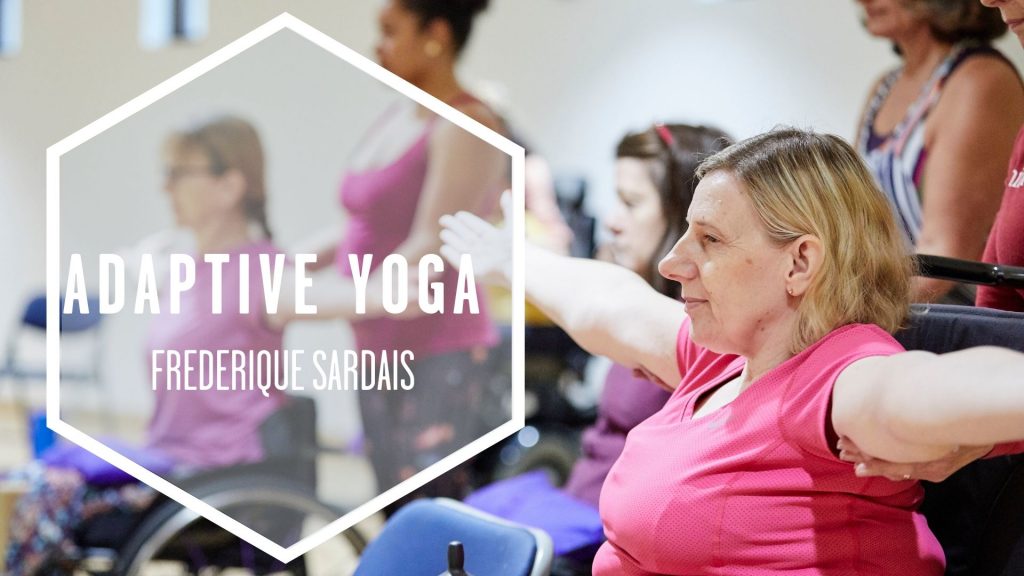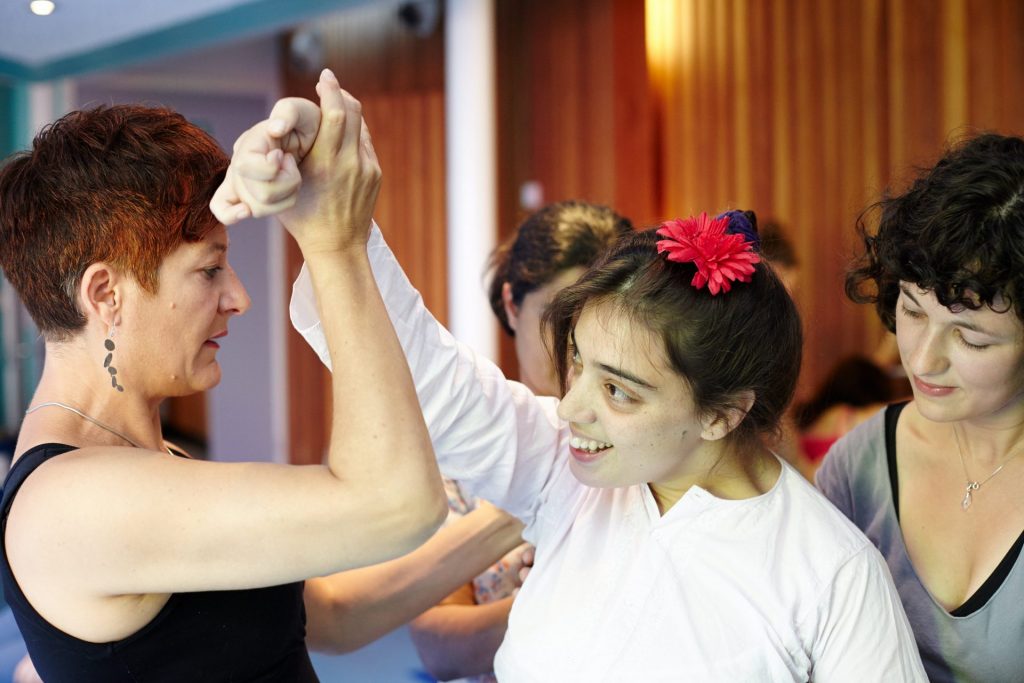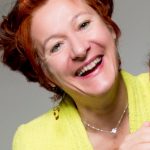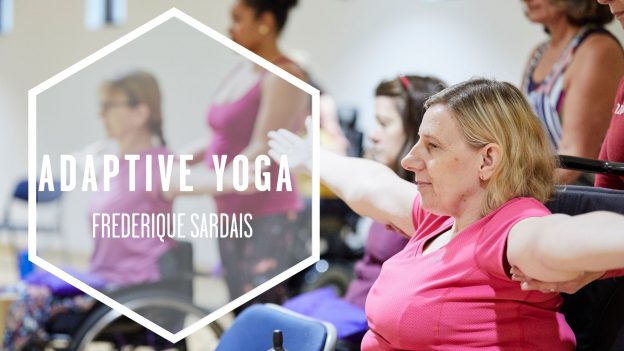
Have you ever wondered whether yoga is inclusive? Or thought about how more people could benefit from yoga? Yoga teacher Frederique Sardais tells us about adaptive yoga and how this approach makes yoga more accessible.
Who is yoga for?
Yoga in its principles is for all and any of us. On a practical level, the moment we reduce Yoga to Asana practice, then the answers begin to vary. In 2012 I trained in adaptive yoga with Matthew Sanford ( Mind Body Solutions, USA), himself a paraplegic yoga teacher. One of Matthew’s famous quotes is “Yoga doesn’t discriminate, yoga poses do”.
From there, there’s endless scope to start working out how to make yoga a more accessible experience available to all.
What is adaptive yoga and who is it for?
Adaptive yoga is for people living with disabilities, trauma, disconnect. This is a broad statement, one that would encompass pretty much all of us at some point in our lives. More specifically, the students who attend my classes are living with a wide range of mobility disabilities. This includes: long term conditions; trauma; and pretty much anyone who feels they would not fit in a regular class because their individual needs are not met.
What tends to happen in a class is that all layers of ability/disability, trauma, and disconnect intersect, as for most there’s no separation between living with spinal cord injury, dealing with the trauma of the cause of SCI and addressing the level of disconnect between the body and mind. Overall the classical rehab system takes care of preparing people for an independent lifestyle as best as possible. There’s great work done there.
In an adaptive class we address the whole of who we are, at all times, so the notion of “overcoming one’s disability” by using the parts of the body that work well is not the model in place. Rather we explore how to feel more integrated in the whole of our being.
You teach Hatha yoga and also yoga therapy, so how did you ‘find’ adaptive yoga?
I trained at first in Classical Hatha and Astanga. In time my own journey of coming to yoga to address chronic pain led me to explore the more yoga therapy or remedial styles.
Adaptive yoga happened by chance. I had a conversation with a local RAF commander who wanted to know whether we could teach their pilots & crew who’d become disabled after being injured in action.
The only person at the time, 2011, teaching anything like this was Matthew Sanford. I read his book “Waking”, joined his London workshops & on attending a demo adaptive class decided that this was what I wanted to do next.
It touched the part of me that had always felt inadequate in yoga classes because of living with chronic pain & “a body that didn’t bend like most”.
I booked to train with Matthew and his team in Minnesota the following April.
In 2012 I started the 1st UK adaptive class in the lineage of Matthew’s work.
At the time I thought I was going to learn a specialist approach to teach people living with disability.
Instead I learned to practice and teach based on the universal principles of yoga. The result: I’d say all my students practice adaptive yoga, whether in classical hatha classes, peri-natal, children’s or senior classes.
What is the difference between adaptive yoga and yoga therapy?
Adaptive yoga is a coming together as teachers, students, assistants, carers, closer to the heart of yoga. It is a co-creation based on the individual’s needs and circumstances.
The emphasis is on sharing the gifts of yoga with all without focusing on trying to fix the conditions people live with.
It is not a prescriptive approach, but rather based on, as teachers, understanding better the heart of our personal practice so as to better share the universal principles of yoga with any student. In the process, of course, things happen, evolve, physical, mental, emotional well-being can improve, but isn’t that also why you and I choose to practice?

In your classes do able-bodied students practice alongside people living with mobility challenges?
This is an interesting question. In essence I teach the same thing in all of my classes: an exploration of the core sensations of grounding, inner space, expansion, balance, rhythm etc. So, yes, it happens. But over the years I’ve chosen to keep the specialist adaptive classes specifically for students who need them because there are too few such classes offered.
Adaptive yoga is not very well known in the UK – what is your vision for adaptive yoga in the future?
This has been a long evolving vision that’s fed my dream since 2011: to share the gifts of adaptive yoga with our community of yoga teachers by offering trainings so more of us can offer classes locally
You approach teaching yoga from a very inclusive standpoint, and offer yoga to all ages and abilities. What three things would make yoga and yoga spaces more inclusive?
1)Information: We need to spread awareness of the fact that specialist classes do exist, that teacher training is available here in the UK and Europe (3 of us have been personally trained by Matthew Sanford and his team to do so) and of course back in the USA with Matthew Sanford.
2)Visibility: as teachers and studios it is time to show less of the extreme Insta poses and share more of the everyday yoga so more people identify with what is in the media. It may not be as visually spectacular, but that will do us all good, bring us back from yoga as a physical achievement to the true beautiful unique inner experience that it is.
3)Financial accessibility: adaptive yoga classes are rarely lucrative. In my experience it’s been the main reason yoga studios decline offering adaptive classes (the second one is: not being truly fully wheelchair accessible).
There is public funding available for classes: yoga studios need to choose to dedicate time and effort to access the funds.
Support from our local sports/community centres/yoga studios: in the last year of training teachers in the UK in adaptive yoga we saw several sports centres/studios pay for teachers training.
So let’s come together as a teaching community and brainstorm, share ideas, support etc.
Set up a “Pay It Forward” system in all yoga studios to subsidize access for students on low income/benefits would go a long way!
I’ve had the pleasure of seeing in the last year Louise Edwards, an adaptive student, truly committed to seeing this approach available to more people. She set up a CIC, “Adaptive Yoga Network”, to help teachers trained in adaptive yoga get their first class off the ground.
What can venues / studios do to make their spaces more inclusive and welcoming to students with differing needs? Is it a question of language, equipment, imagery, space, additional props?
The starting point is to ensure that the venue (studio, changing rooms, bathrooms, parking) are fully wheelchair accessible (both electrical and manual).
Then hire teachers with the right skill set. A suitable set of props is important. Then they need to spread awareness of the classes they offer through local authorities, media, social workers, social media.
Where would people find adaptive yoga classes? And are there many adaptive yoga teachers being trained in the UK? Can someone with mobility challenges currently train as a yoga teacher in the UK?
For the time being Googling adaptive yoga is still the simplest way to come across class listings.
Last year we trained about 20 yoga teachers to adaptive yoga in the UK and 24 in Italy. A few more have gone directly to Mind Body Solutions in the USA to train with Matthew. I would think there are about 30 if us UK side.
I have all hope of continuing training teachers in the UK.
At this point someone with mobility impairment training as a yoga teacher in the UK remains a grey area. Most classical TTCs (needed as a stepping stone to specialist training in adaptive yoga) are not accessible. It would be for each individual participant to explore by contacting many different training schools.
How has 2020 and the restrictions on social interaction changed adaptive yoga?
Overall I’d say Adaptive classes have been the most affected. Where classical yoga shifted quickly to online, it’s been a slower exploration for adaptive students. Many can’t practice without in person help.
But over time we’ve seen great things happen: Adaptive Yoga Live, created by Miranda McCarthy, London adaptive student offers free online classes for all. Mind Body Solutions, where I trained in the USA have also added a lot of teaching and learning support on their YouTube channel.
This month, October 2020 I’m joining many teachers from the world over in a 3 day online course with Mind Body Solutions to further explore and improve how we teach via Zoom and similar platforms. In November I’ll be starting a series of Adaptive Yoga teachers CPD workshops to offer support to the people who trained in Adaptive Yoga with us in the UK last year.
Hopefully 2021 will see the chance to resume the full teacher trainings in Adaptive Yoga, you will find all the latest news on my website.
If you want to find out more about Adaptive yoga and Fredee’s work, tune in to our podcast.
About Frederique Sardais:

Frederique Sardais is a Yoga teacher and an Adaptive Yoga teacher and teacher trainer. She has been teaching for 20 years. Her areas of specialist training are: classical yoga;adaptive yoga (for people living with disabilities, trauma, disconnect) in the lineage of Matthew Sanford and Mind Body Solutions; peri-natal yoga (Birthlight Trust trained); varied yoga therapy modules.





This is such a great piece with useful information – inclusivity is such a buzzword right now and I’m so glad that MFML is supporting this on its wonderful platform – thankyou!